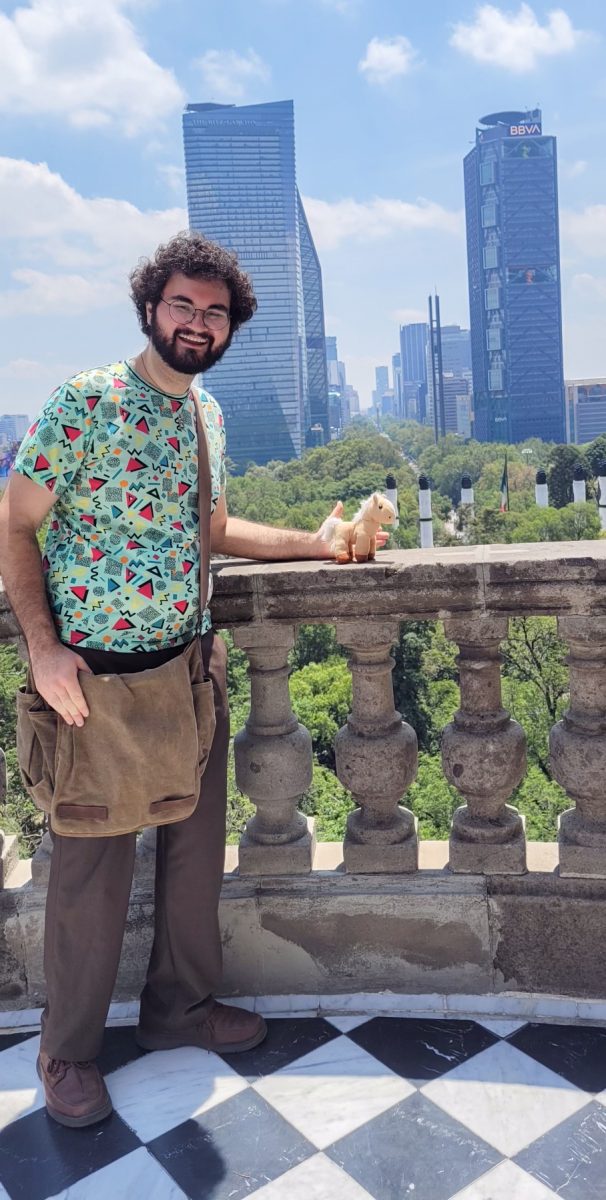Over the summer, I had the incredible opportunity to study abroad in Mexico City. It was a dream come true!
Mexico City is a city of contrasts, where different eras of history coexist next to one another. The city was founded over five hundred years ago by indigenous people from the region—the Mexica, better known as the Aztecs. However, rulers like Montezuma would not recognize the city if they were alive today. Everything about the landscape has changed, besides the volcanoes in the distance and the earthquakes that still haunt the city. However, the previous eras of Mexico City are not truly gone. If you look closely, you can see the different eras that the city lived through reflected in the architecture and design of the city. This is exactly what makes Mexico City so unique; it looks as though five centuries of history has been condensed into a single moment.
Mexico City was once Tenochtitlan, the capital of the Aztec empire. Originally, the valley of Mexico looked a lot different. Today, Mexico City is a sea of concrete; however, the valley was once home to a large lake named Lake Texcoco. The Mexica built their capital in the lake itself using their signature technology of floating gardens or “chinampas.” The largest building was Templo Mayor, which was the center of religious life in the city. The ruins of Templo Mayor are now a museum, and I made sure to visit it during my two months in the city. There is something truly awesome about standing on ground you know to be ancient and imagining what it must have been like to see it the way ancient people saw it.
The Spanish destroyed Templo Mayor, and they even tried to drain Lake Texcoco. Really, all they did was push it underground. This causes parts of the city to sink and to rise; sidewalks will crack and become uneven. The famous Ángel de la Independencia has risen year after year, requiring the creation of new steps to reach it. It’s easy to feel connected to history in Mexico City because you’re literally walking over it with every step. This makes Mexico City a fantastic city to get lost in.
There’s always something new to discover when exploring the city. You’ll pass through time every block, as colonial apartments give way to modern skyscrapers. Every sidewalk is full of stands selling everything from classic street food like tacos to cheap books to stuffed animals. It’s difficult to get tired of walking down these dense and friendly streets. Every neighborhood is also accessible from any other through the city’s excellent metro system, with fast trains coming once every few minutes. It was really hard to come back to the MBTA after my visit.
I stayed in the beautiful Coyoacán neighborhood, a short walk from Frida Kahlo’s famous blue house. Everything I wanted was just a few minutes down adorable cobblestone alleyways—the historic center with a beautiful fountain, local market and free cultural activities all day. There was also a large nature reserve and park where I could go to relax, as well as metro stations that would take me anywhere else in the city I’d like to go.
The best part was that it was only a fifteen-minute walk to the famous National Autonomous University of Mexico—UNAM, in Spanish—where I was taking my study abroad classes. The part of the university they taught foreigners in was beautiful, as was the rest of the campus. There was a large garden and recreational space in the center, with a café for food between classes. Every class I was in had less than ten students, creating a personal learning experience that motivated me to push myself. They had classes for every skill level of Spanish, so I met and practiced with students from other skill levels to help one another out. My classes were very helpful with improving my Spanish, but the greatest part was being immersed in the language and culture even outside the classroom. I learned more in those two months than I did in my previous two years of studying Spanish here.
Mexico is a country of syncretism, of indigenous and Spanish religion and culture. Of course, this is best seen in the Virgen de Guadalupe, a Mexican version of the Virgin Mary who is said to have appeared to an indigenous man and spoke to him in his own language. The modern basilica dedicated to her is huge and functional, in contrast to the small and ornate basilica that came before it. The two churches are neighbors in the same square, though they appear to be from different planets. In Mexico City, you can traverse all five hundred years of Mexican history just by walking down the street. You will read street names dedicated to Juan Diego, Father Hidalgo, Benito Juárez, and Emiliano Zapata as though they coexisted with one another. Today, street vendors roll out rugs and sell their wares on it just like the Mexica of Tenochtitlan did over five centuries ago. That’s impressive as it is beautiful. I highly recommend studying abroad in this incredible city.

